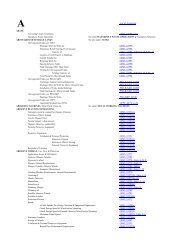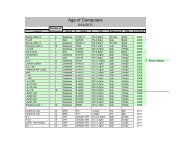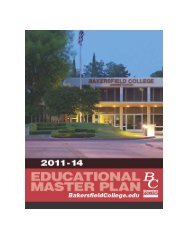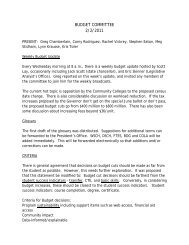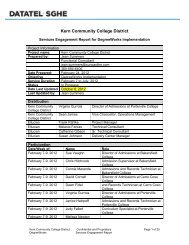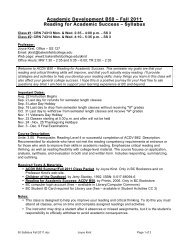Addendum with evidence (8.2 MB) - Accreditation - Bakersfield ...
Addendum with evidence (8.2 MB) - Accreditation - Bakersfield ...
Addendum with evidence (8.2 MB) - Accreditation - Bakersfield ...
You also want an ePaper? Increase the reach of your titles
YUMPU automatically turns print PDFs into web optimized ePapers that Google loves.
The community colleges may be helped by federal legislation to consolidate student loan<br />
programs <strong>with</strong>in the US Department of Education and increase the amount of Pell funds per grant.<br />
However, recent Congressional proposals to curtail the Pell grant awards may hurt the colleges and<br />
students. The long-term impact remains to be seen. President Obama has signed an executive order<br />
to align the monthly repayment rate of federal loans to the level of future wages earned by the<br />
student. That may ease the burden of debt for students and make the act of borrowing for a college<br />
education more feasible for prospective students.<br />
After the Higher Education Opportunities Act was passed by Congress in 2008 a series of<br />
new federal regulations have been issued to improve program integrity where Title IV financial aid<br />
funds are involved. Regional accrediting bodies are now expected to provide closer scrutiny of<br />
member institutions on a range of new topics such as:<br />
• The analysis and use of student achievement data, expressed at a variety of levels and in<br />
different ways, to improve programs and services.<br />
• Specific attention must be given to the institution’s longitudinal data on student<br />
achievement, disaggregated and analyzed in a variety of forms, to identify any concerns<br />
about stability and achievement of the institution’s mission.<br />
• Conformance of credit hours awarded to the “Carnegie Unit” standard as found in a variety<br />
of curriculum and instructional settings.<br />
• The efficacy of methods that the institution uses to verify the identity of students enrolled in<br />
distance and correspondence education classes and steps taken to preserve the integrity of the<br />
credits and grades awarded.<br />
• Public disclosure of educational costs and employment prospects for students in any career<br />
and technical program designed to prepare those students for gainful employment upon<br />
graduation.<br />
In part, stimulated by prior federal government actions, regional accrediting bodies are<br />
insisting that greater attention be given to student learning outcomes. The expectation by the<br />
Accrediting Commission for Community and Junior Colleges (ACCJC) is that proficient assessment<br />
processes will be routinely practiced at the course, program, and degree levels by all member<br />
institutions by fall 2012.<br />
These new areas are in addition to the traditional goals of accreditation:<br />
1. Providing assurance to the public that the education provided by the institution meets<br />
acceptable levels of quality<br />
2. Promoting continuous institutional improvement<br />
3. Maintaining the high quality of higher education institutions in the region<br />
Although subtle, the Commission has changed the term used for the initial phase of the<br />
comprehensive reaccreditation process from a self-study to a self-evaluation. The change underscores<br />
22



